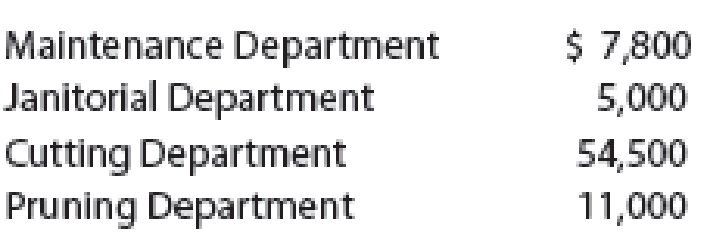
Concept explainers
Christmas Timber, Inc., produces Christmas trees. The trees are produced through a cutting and pruning process. Machine maintenance and janitorial labors are performed throughout the production process by nonproduction employees. Maintenance and janitorial costs are allocated based on machine hours used and the number of trees in each department, respectively. The company estimates that the cutting and pruning areas typically have about 20 and 60 trees, respectively, in them at one time. The company also estimates that the cutting process requires about 9 times as many machine hours as the pruning process. The total costs of each department are as follows:

Using the direct method of support department cost allocation, determine the total cost of each production department after allocating all support costs to the production departments.
Want to see the full answer?
Check out a sample textbook solution
Chapter 5 Solutions
Managerial Accounting
- Can you explain this general accounting question using accurate calculation methods?arrow_forwardI need guidance with this financial accounting problem using the right financial principles.arrow_forwardCan you solve this general accounting question with accurate accounting calculations?arrow_forward
- Andrews Corporation manufactures CropGuard. Each container of the product contains 45 pounds of direct materials. 12% of the materials are lost during manufacturing. The budget allows direct materials to be purchased at $5.25 per pound under terms of 2/10, n/30. The company's policy is to take all available cash discounts. Determine the standard direct materials cost for one container of CropGuard.arrow_forwardI am searching for the correct answer to this general accounting problem with proper accounting rules.arrow_forwardPlease provide the correct answer to this general accounting problem using valid calculations.arrow_forward
 Managerial AccountingAccountingISBN:9781337912020Author:Carl Warren, Ph.d. Cma William B. TaylerPublisher:South-Western College Pub
Managerial AccountingAccountingISBN:9781337912020Author:Carl Warren, Ph.d. Cma William B. TaylerPublisher:South-Western College Pub Cornerstones of Cost Management (Cornerstones Ser...AccountingISBN:9781305970663Author:Don R. Hansen, Maryanne M. MowenPublisher:Cengage Learning
Cornerstones of Cost Management (Cornerstones Ser...AccountingISBN:9781305970663Author:Don R. Hansen, Maryanne M. MowenPublisher:Cengage Learning

